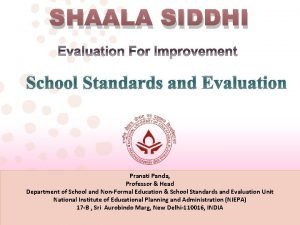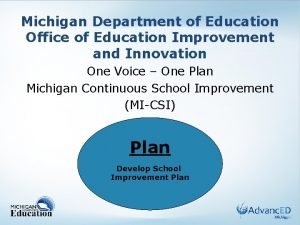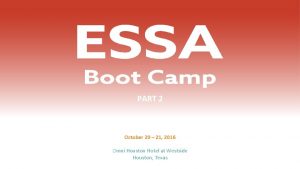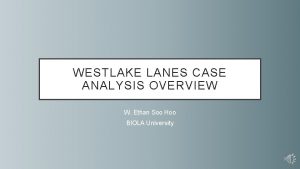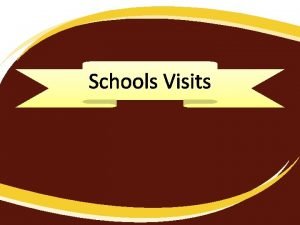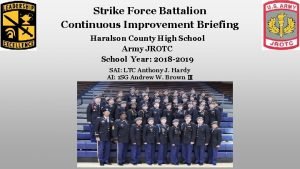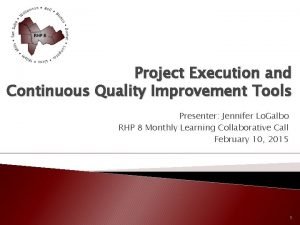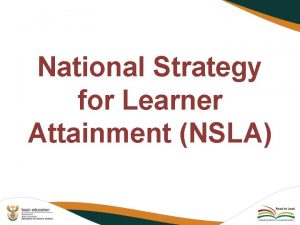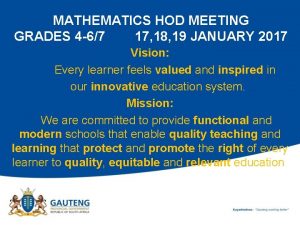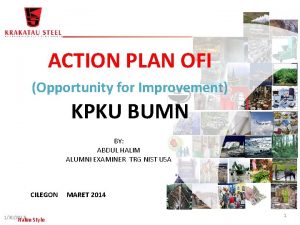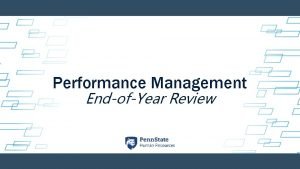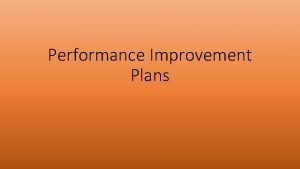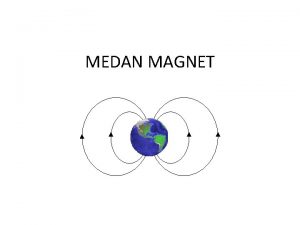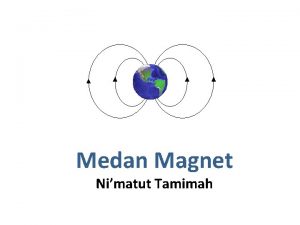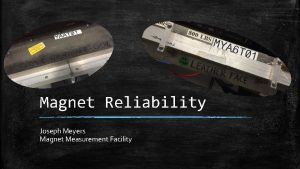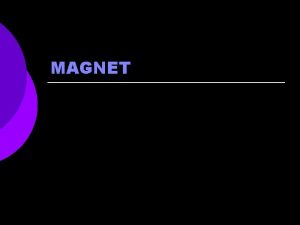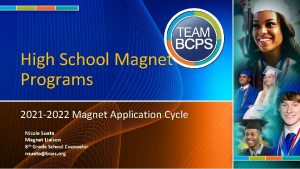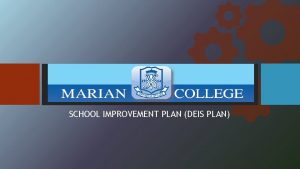Westlake Magnet School Improvement Plan Visit us at
























- Slides: 24

Westlake Magnet School Improvement Plan Visit us at: twelvelakesschooldistrict. weebly. com Amy Anderson Lara Bohlke Tiffany Rauch EDL 689 -80 Fall 2014 Dr. Sousan Arafeh

Westlake Magnet School Vision: Educational Excellence for All. Mission: The Westlake Magnet School Community will empower student ambassadors to achieve their personal best by providing a culture of academic excellence. We aim to promote and sustain a safe learning environment where students are taught by caring and knowledgeable educators in cooperation with supportive and involved families.


School Demographics Descriptor District Data Westlake Data Difference Students Eligible for Free/Reduced-Price Meals 82. 1% 86. 5% +4. 4% K-12 Students Who Are Not Fluent in English 19. 3% 53. 7% +34. 4% Students with Disabilities 13. 9% 7. 5% -6. 4% Students identified as Gifted or Talented 1. 1% 1. 8% +0. 7% Kindergarten Students who Attended Preschool, Nursery School or Headstart 78. 4% 99. 0% +20. 6% Students in Grades Above School’s Entry Grade who Attended Same School the Previous Year 98. 4% 99% +0. 6% K-12 Students in Bilingual Education Program or Receiving English as a Second Language Services 19. 1% 53. 7% +34. 6%

Targeted Goals for Improvement Westlake Magnet School’s mission, vision and goals establish high expectations for all students and staff and are shared, widely known, and implemented to improve student performance. Westlake Magnet School sustains a collaborative professional culture that ensures the success and achievement of all students by monitoring and continuously improving teaching and learning.

Critical Area of Focus #1 Improve Culture and Climate

Student, Parent & Staff Climate Surveys Disagree Strongly Disagree Students in my classroom are kind and supportive of one another. 22% 12% My teachers really care about me. 24% 11% I am happy to be at this school. 22% 7% Most kids in my class follow the rules. 17% 10% Kids in my school are friendly. 30% 19% The school clearly communicates its expectations for my child’s learning. 23% 8% I have opportunities for involvement at this school. 19% 12% The school environment supports learning. 20% 9% Staff morale is high at this school. 26% At this school, there is honest communication on important school issues. 28% 2% The school’s discipline program is effective. 30% 2% Student Survey Descriptors Parent Survey Descriptors Staff Survey Descriptors

Student and Parent Survey Comments Of the 426 students and staff who commented, general trends were in the areas of: 1. Culture and Climate: lack of student respect for one another bullying general disrepair/cleanliness of building lack of engaging course/extra-curricular offerings 2. Perception of Lack of Connectedness to Westlake community: lack of respect between students and staff minimum teacher awareness of obvious student issues minimum engaging instruction lack of opportunities for family involvement in school-related events both during and outside of school hours Lack of access to essential resources and technology

Cont. Critical Area of Focus #1 Improve Climate & Culture Based on trends in data and student and parent feedback, we can conclude: students and parents do not feel connected to the school community student do not feel as though they are respected parents and staff do not feel as though their input is valued regarding school related decisions Goal Statement: Decrease by 50% the number of students and parents who are expressing discontentment with the climate and culture at Westlake by Spring 2015. SIP, Goal 3: Establish and maintain an organizational system and resources for a safe, high-performing learning environment. Connecticut Leadership Standards: Performance Expectation 1: Vision, Mission and Goals: ‘…development and implementation of a shared vision of learning, a strong organizational mission, and high expectations for student performance. ’

Cont. Critical Area of Focus #1 Action Plan and Recommendations Climate Committee will address concerns using two or more of the following: Well-Managed Classroom (WMC) Training for Staff, Parents and Administrators Feedback Loop (surveys) for Staff and Parents Team Building for Students, Staff, and Parents School Governance Council (SGC)/PTO involvement Differentiation

Cont. Critical Area of Focus #1 Measurable Outcomes Decrease by 50% the number of students who disagree with survey statements regarding climate and culture. 95% participation rate for students and staff in positive climate building activities. Increase participation rate for families in positive community-building school activities from 15% to 25%

Critical Area of Focus #2 Improve Math Achievement

CMT Math Data Percent of Westlake Students Meeting State Goal on CT Mastery Test Spring 2013 Grade School District State 3 10. 2 25. 0 66. 5 4 9. 1 24. 3 68. 0 5 12. 3 26. 6 71. 6 6 8. 5 20. 1 69. 3 7 6. 3 23. 1 68. 1 8 7. 6 21. 2 67. 2

NWEA Math MAP Data Percent of Westlake Students Meeting Projected Growth on MAP Assessment Fall 2013 to Spring 2014 Grade Non-ELL District K 50. 3 55. 4 72. 7 1 39. 4 40. 0 69. 8 2 48. 7 38. 4 64. 5 3 51. 6 45. 3 69. 9 4 43. 0 43. 6 61. 2 5 45. 5 33. 2 56. 2 6 38. 9 36. 1 56. 8 7 42. 6 36. 2 50. 9 8 40. 5 42. 0 55. 7

Math Fluency Data Percent of Westlake Students Meeting Fluency Standard on District Assessment Fall 2013 to Spring 2014 Grade ELL Non-ELL District K 50 67. 8 80 1 57. 7 66. 0 83 2 34. 8 45. 4 58 3 21. 4 41. 9 52 4 40 50 55 5 18. 8 30 40 6 15. 9 20 32 7 8. 1 10. 2 16 8 5. 2 15. 1 38

Cont. Critical Area of Focus #2 Increase Math Achievement Based on trends in data and current research, we can conclude: our student growth in mathematics is stagnant or declining mathematics instruction is not meeting the diverse needs of our students the level of rigor of math instruction is not preparing our students for high school Goal Statement: As an indicator of student growth in mathematics, increase by 20% the percent of students meeting projected growth on future Math MAP Assessments SIP, Goal 2: Monitor and continuously improve teaching and learning. Connecticut Leadership Standards: Performance Expectation 2: Teaching and Learning : ‘… monitoring and continuously improving teaching and learning. ’

Cont. Critical Area of Focus #2 International Influences Based on current research, we can conclude: it is important to consider the definition of social class groups, the selection of comparison countries, and the determination of when differences in test scores are truly meaningful. average math scores in the United States would be about the same as average math scores in similar post-industrial countries when using a social class distribution that is similar to the distribution in countries to which the United States is compared. TIMSS and PISA failed to consider the social class of the groups being compared.

Cont. Critical Area of Focus #2 Action Plan and Recommendations Curriculum Committee will address concerns using two or more of the following: Embedded ELD (English Language Development) professional development and coaching Evaluation of curriculum and assessments to ensure cultural responsiveness and accessibility for all learners. Use of multi-modal and multi-sensory approaches to teaching (use of math manipulatives, pictorial representations, etc. ) Book study Differentiation

Cont. Critical Area of Focus #2 Measurable Outcomes Increase the percent of students meeting projected growth on future Math MAP assessments by 20%. Increase the frequency of teachers using ELD instructional methods as measured through informal & formal observations, observational rounds and walkthroughs.

Connections to School Law & Policy Federal law requires school districts to ensure that students with limited English language proficiency have an opportunity to participate equally in educational programs Instructional coaching sessions to transform our instructional approach to meet the needs of our diverse learners. At Westlake, all students are exposed to the same rigorous content and curriculum. The instructional methods, strategies, and pedagogy are specialized and differentiated to meet the needs of our diverse ELL population.

Summary Checkley (2014) reminds us to: “Never underestimate the capabilities of English language learners (ELLs) …when mainstream and language teachers collaborate and shoulder instructional demands together, all students have opportunities to succeed” (p. 1).

References pg. 1 References � Boykin, A. W. & Noguera, P. (2011). Creating the opportunity to learn: Moving from research to practice to close the achievement gap. Alexandria, VA: ASCD. � Checkley, K. (2014). Setting ELLs up for success. ASCD Education Update, 56(10), 1 -7. � � � Connecticut State Department of Education. (2012). Common core of leading: Connecticut school leadership standards. Hartford, CT: CSDE. Retrieved from http: //www. sde. ct. gov/sde/cwp/view. asp? a=2641&Q=333900 Economic Policy Institute. (2013). What do international tests really show about U. S. student performance? Washington, DC: Carnoy, M. , & Rothstein, R. Friend, J. , Most, R. , & Mc. Crary, K. (2009). The impact of a professional development program to improve urban middle-level English language learner achievement. Middle Grades Research Journal, 4(1), 53 -75.

References pg. 2 References � Galley, M. , Hoff, D. J. , & Manzo, K (2001). Girls’ math scores linked to role models. Education Week, 21(8), 20. � Kersaint, G. , Thompson, D. R. & Petkova, M. (2009). Teaching mathematics to English language learners. New York, NY: Routledge. � � Kim, S. , & Chang, M. (2010). Does computer use promote the mathematical proficiency of ELL students? . Journal of Educational Computing Research, 42(3), 285 -305. � Mooney, T. B. (2012). A practical guide to Connecticut school law (7 th ed. ). Wethersfield, CT: Connecticut Association for Boards of Education (CABE). � � � Murnane, R. J. (2007). Improving the education of children living in poverty. Future of Children, 17(2), 161 -182.

References pg. 3 References � NAEP says urban districts better in math, lag in reading. (2006). Reading Today, 23(4), 4. � Sheldon, S. , & Epstein, J. (2006). Not just numbers: Creating a partnership climate to improve students’ math proficiency. Conference Papers – American Sociological Association, 1. � Snyder, T. D. , Freeman, C. E. (2003). Trends in Education. Principal, 83(1), 5052. Tillman, L. (2008, July 8). Report: ELL students struggle with math after third grade. Brownsville Herald, The (TX). � � Wooley, M. E. , Grogan-Kaylor, A. , Gilster, M. E. , Karb, R. A. , Gant, L. M. , Reischi, T. M. , & Alaimo, K. (2008). Neighborhood Social Capital, Poor Physical Conditions, and School Achievement. Children & Schools, 30(3), 133 -145. �
 Westlake magnet
Westlake magnet Naviance westlake high school
Naviance westlake high school What happens when you break a magnet in half
What happens when you break a magnet in half Difference between permanent magnet and temporary magnet
Difference between permanent magnet and temporary magnet Kata magnet berasal dari magnesia
Kata magnet berasal dari magnesia Class wise annual attendance rate
Class wise annual attendance rate Annual implementation plan
Annual implementation plan School improvement plan michigan
School improvement plan michigan School improvement plan
School improvement plan Westlake lanes case study
Westlake lanes case study Westlake utility house
Westlake utility house Preschool westlake
Preschool westlake Sales visit plan
Sales visit plan Chapter 6 brave new world
Chapter 6 brave new world School visit report
School visit report Performance improvement plan examples
Performance improvement plan examples Bravo company motto ideas
Bravo company motto ideas Continuous quality improvement plan example
Continuous quality improvement plan example Ohio state health assessment
Ohio state health assessment Gauteng north strategy for learner attainment memo
Gauteng north strategy for learner attainment memo Hod management plan
Hod management plan Contoh format action plan
Contoh format action plan Housekeeping items for meetings
Housekeeping items for meetings Service improvement plan for service desk
Service improvement plan for service desk Kpi improvement plan
Kpi improvement plan





